 Wild life abounds on sexploitation safari. 
This free-spirited poster was made for the sexploitation flick Africa Excitaction, which was originally French/Italian made and realsed in the U.S. as Jungle Erotic. The main brain behind the production was Polish writer-director Zygmunt Sulistrowski, who also stars under the name Don Power, because, if you're gonna write and direct a horny epic, it might as well be you doing to grinding and gyrating. Even simulated sex can be fun—so we hear. Zygmunt didn't star as himself, but as Darr Poran. In addition, the listed actresses, Karen Roche and Mary Alexander, were credited as Carrie Rochelle and Alice Marie. It almost seems as if nobody wanted their names on this movie.
Plotwise, there's nothing complex here. Zygmunt takes two models and his amphibious car to Africa for an extended photo session and some employer-on-employee al fresco lovin'. That may sound fun, but the movie is basically a total loss. It's not coherent, and nobody can act. But—and there's always a but—it's a sexploitation flick, which means all it really needs is to deliver scenery, skin, and sin. The first comes from shooting in Tanzania and Uganda, the second is provided by co-stars Rochelle and Marie, and the third—well, there's plenty of softcore writhing. So in the end, you win. Africa Excitaction has no precise premiere date, but it debuted in 1970.
  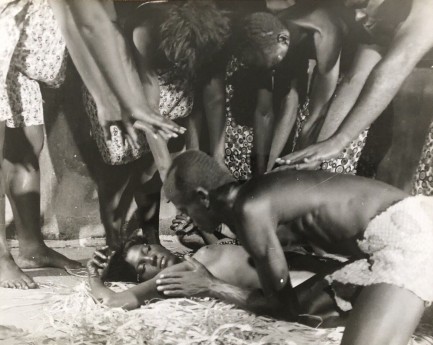  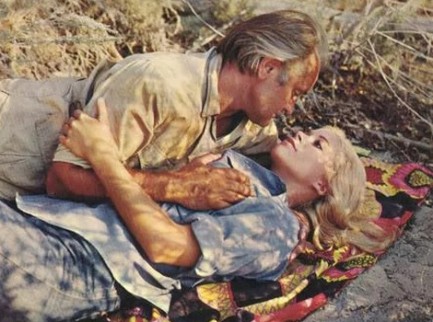  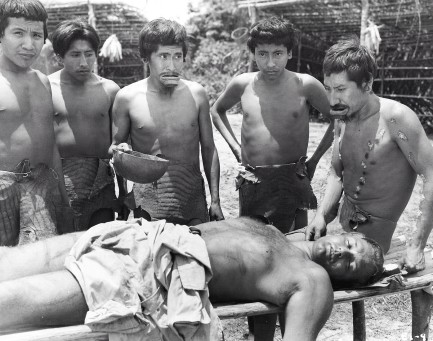   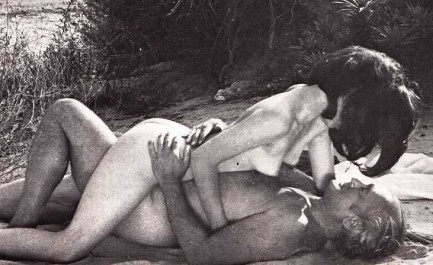 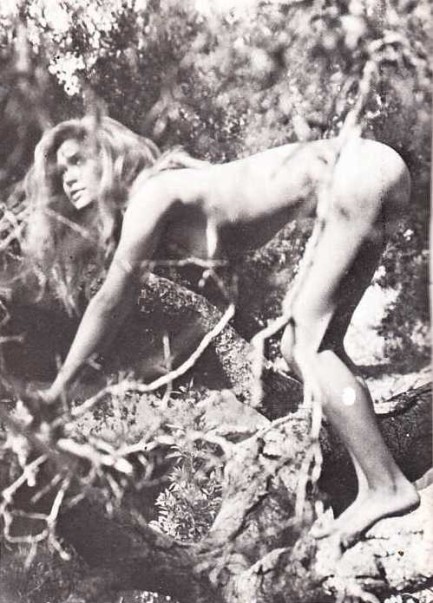 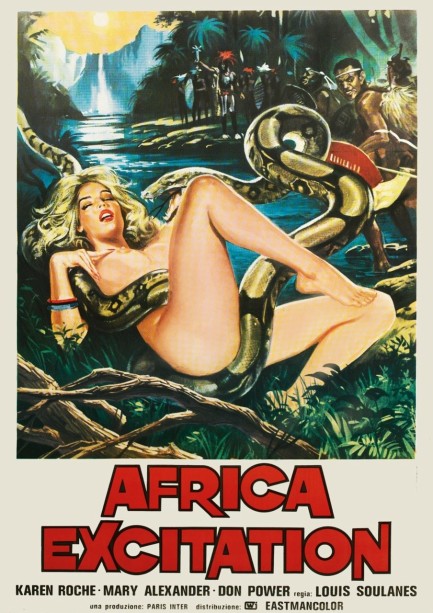
 Hemingway scales the literary heights by plumbing human depths. 
The great film director John Huston once made an interesting observation about Ernest Hemingway. He said Hemingway had fallen out of fashion because he wrote about courage. Huston didn't mean courage like Liam Neeson facing a pack of wolves or a terrorist. He meant the willingness to face temporality and mortality, and accept them for what they are. He meant the willingness to try to achieve things of great personal value while realizing none of them would last, and none of them truly mattered. The cultural trend has always been to tell people they're special and what they think and do matters and will last. But Hemingway considers that a conceit. 99.99999% of people are simply forgotten. The things they did are forgotten too.
This has happened to the most famous people of their eras. Name a U.S. governor who was in office during the Civil War. Name the wealthiest landowner of imperial Rome. They probably never imagined they'd be forgotten. Human temporality and mortality, set against the backdrop of nature or conflict, is Hemingway's thing. Nihilistic themes date from the earliest literature, but Hemingway, in projecting these ideas through a modern, almost pop culture lens, spoke for generations who had experienced two of the largest and deadliest wars in human history—we're talking well over 100 million dead. Hemingway was wounded in Italy in 1918. George Orwell was shot through the throat in Spain in 1937 during a precursor conflict to World War II. Erich Maria Remarque sustained multiple wounds in World War I. Imagine literature without them.
100 million war dead, among them writers who never wrote, painters who never painted, inventors who never invented. The world lost untold human capital, immeasurable progress. The literary public was ready for authors to tackle the senselessness of warfare. The between-wars period, encompassing a flu pandemic that killed 50 million, followed by the Great Depression, was likewise a wellspring of disillusionment. All these upheavals made clear that everything hangs by the barest thread. That level of suffering is unknown in the U.S. today, a country that has had its constant warfare sanitized for easy consumption, and that's really why Hemingway is out of favor—because his themes are almost alien to an American public that has forgotten what it means to suffer on a mass scale.
But while it's been fashionable for the last forty or so years to bash Hemingway, it's a self defeating exercise. We think what people usually mean to bash is his stature, or his out-of-date attitudes, which are understandable criticisms. However, to say he's a bad writer is to make oneself look ridiculous. We've said a few times before, and we'll say again here, that a good writer teaches you how to read their work. It's similar to the idea of willing suspension of disbelief in cinema. You accept the premise, or don't bother watching the film in the first place. It's okay to dislike a book as long as you try to read it on the terms the author asks. Otherwise, why bother? You read an adventure author on his or her terms, a mystery author on their terms, and a sleaze author on their terms. And certainly, you read a literary author on their terms.
None of this is to say Hemingway didn't have flaws, particularly when viewed trough a modern social lens. At Pulp, we tend to view writers as content producers first. For example, we pointed out recently that Camilo José Cela was a fascist. We personally are the opposite. But Cela still could write. Seeking enrichment only from ethically pure artists makes for a meager diet, and ethical purists should be forewarned—though modern judgments are necessary tools for measuring our progress, judgments come down the pike for everyone eventually. Legions of twenty-somethings who think they're pristine will one day be blamed for enabling slavery because they used smartphones dependent upon forced labor in African cobalt mines. Ethics evolve, and generational judgment comes for all.
Green Hills of Africa, originally published in 1935, with the Perma Books edition you see above coming in 1956 with Robert Schulz cover art, is autobiographical. A thirty-six year old Hemingway goes on safari mainly in Tanzania, and sets his personal goals against vast and indifferent wilds. By design nothing important seems to happen, but through his descriptive powers he brings Africa to the fore, and makes himself a bit player, just an ant on the endless landscape. The narrative could be shorter and more focused, but even as it rambles the same way Hemingway rambles across the dry plains, his wide ranging hunt for kudu, rhino, and lion assumes an almighty personal importance. His desire draws you in. His many small triumphs and failures become increasingly gripping, and sharpen the irony of his own impermanence and the impermanence of his acts.
But as we've mentioned before, Hemingway and his ilk operated under an earlier—and mistaken—ecological understanding. Our acts actually do matter, not because we're individually important, but in the accumulation of our billions of tiny effects. Hemingway assumed humans had no meaningful impact on nature. Now we know that's only half true—we're impossibly insignificant and incredibly impactful. We're tiny animalcules that have heedlessly wrecked a vast ecosystem. Green Hills of Africa is like a work of high fantasy, taking place in a reality that never truly existed. Despite its mistaken assumption, it does exactly what Hemingway wanted—says that nature is implacable, while human acts, achievements, and loves are comically impermanent. That was his message, a message people were ready to hear. That was Hemingway.
 Live, survive, thrive—she covered the entire spectrum. 
Above is a lovely image of a person we guarantee you'll find very interesting. Her name is often given as Elizabeth Bagaaya, or Elizabeth Bagaya, but she's also known as Princess Elizabeth of Toro, and she's a Ugandan lawyer, diplomat, politician, and model—not in that order. Let's see if we can get her incredibly wild life story straight. First of all, Bagaaya was a princess because her mother was married to the King of Toro, an ancient kingdom that spanned not only Uganda, but parts of present-day Burundi, Rwanda, Tanzania, and Zaire. Next she was a brilliant student, the first black woman to win admission to the English Bar Association, and, in 1965, Uganda's first female lawyer. In 1967 the Ugandan government under Milton Obote abolished the monarchy and Bagaaya lost her title and became merely a person from a powerful family.
 In 1971 Idi Amin overthrew Obote and installed himself as dictator. Taking notice of Bagaaya, who in addition to her legal background had been modeling for a few years, he appointed her Minister of Foreign Affairs. He had an ulterior motive. He wanted her to become one of his wives. Her answer—a hard no. In 1971 Idi Amin overthrew Obote and installed himself as dictator. Taking notice of Bagaaya, who in addition to her legal background had been modeling for a few years, he appointed her Minister of Foreign Affairs. He had an ulterior motive. He wanted her to become one of his wives. Her answer—a hard no. Amin was displeased by her reticence, and placed her under house arrest. He allegedly had her hair forcibly shaved, and generally made her existence hell, all of which prompted her to escape to Nigeria. Just as an aside—Amin killed up to 300,000 people, maybe even more, but to get a sense of how dangerous he was in his personal life, consider the fact that his second wife, Kay, died under unknown circumstances and her body turned up dismembered, and his fifth wife, Sarah, had a previous boyfriend who vanished and is thought to have been beheaded. Amin wanted Bagaaya, but she was in no way safe because of that.
Anyway, moving on, some of Bagaaya's doings overlap, but the bulk of her modeling came after fleeing from Amin, and when she undertook that profession she gave it her all, becoming the first black woman to have a spread in Vogue, and the first to appear on the cover of Harper's Bazaar. As it was a chic thing for models to do at the time, she posed nude, with the results you see. She also acted, appearing in the films Things Fall Apart and Sheena—yeah, the one with Tanya Roberts. In 1979 she returned to Uganda because Amin was gone, and the country was having elections. She helped former president Obote win, later served as Uganda's ambassador to Germany and the Vatican, and was Uganda's High Commissioner to Nigeria. There's more, but why go on? What we've described, ladies and gentlemen, is called a life, one that is ongoing, as Princess Elizabeth remains an important figure, aunt of the current King of Toro, and an outsize and complex personality.

 She's tougher than Tarzan, meaner than Sheena, and lustier than Gungala. 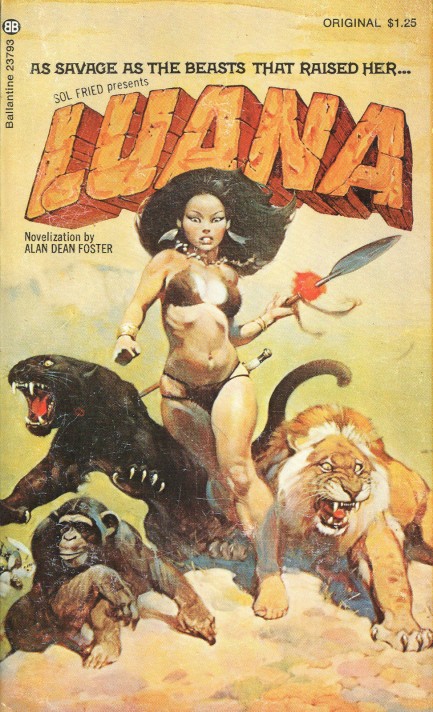
You can look at this cover and correctly assume that we've shared it because it was painted by Frank Frazetta, considered by many to be the master of sword and sorcery art. It's a beautiful piece, rightly famous. Alan Dean Foster is a master too. He isn't what you'd call a significant author in the sense that he's produced lauded original material, but he may be the king of movie novelizations. Among his output: The Black Hole, Clash of the Titans, Outland, Starman, Pale Rider, and The Chronicles of Riddick, as well as novelized series based on Star Wars, Star Trek, and Alien. We love Foster for his Star Wars sequel Splinter of the Mind's Eye, which came out before The Empire Strikes Back (notice we don't bother with that Episode nonsense) and followed Luke and Leia—not siblings in Foster's universe—as they adventured on strange worlds and discovered their love for each other. We still think the film series should have followed Foster's lead, but whatever.
His Luana is a novelization of the 1968 movie of the same name starring Mei Chen Chalais, which we talked about a while back. Sometimes novelizations are published before the film, sometimes after. Foster published Luana six years after the film in 1974 for reasons that are obscure. It was among his first published books. While template for a novelization is provided by the filmmakers, the author is who gives it color and life. Foster fulfills that duty with obvious relish, mining literary and cinematic antecedents like Tarzan, Tarzana, Gungala, Sheena, Shuna, and Ka-Zar for familiar tropes. A kilometer long pit filled with army ants? A lion and panther, both larger than any ever seen before, working in tandem with a huge chimp? A pitched battle between blowgun wielding Tanzanian tribesmen and an expedition of white explorers? A secret city of solid gold buildings? As lost world tales go, by standing on the shoulders of his predecessors, Foster crafts something better than average. And far better than the movie too.
 The statue was for the public. The photos were strictly private. 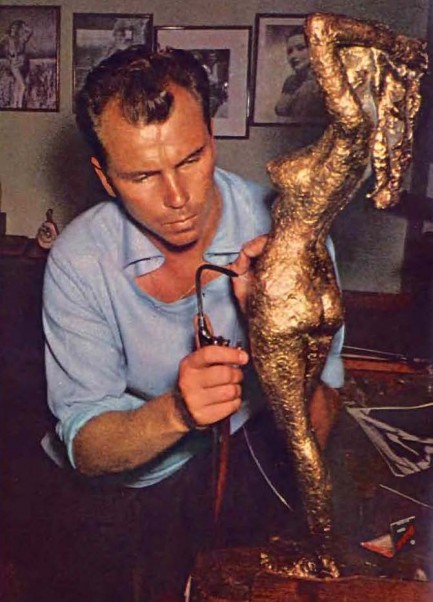
Hungarian artist Sepy Dobronyi puts the finsihing touches on what was for a while possibly the most famous statue in the world—his stylized sculpture of Swedish sex bomb Anita Ekberg. Dobronyi made it by using nude reference photos he'd shot of his subject, and it was those photos, more than the statue, that interested the public. Ekberg was one of the world's biggest stars at the time and the idea that nude shots existed was flogged by the tabloids and helped burnish Dobronyi's reputation as a sort of jetsetting artist. His depiction of her became known as the Ekberg Bronze. He went on to sculpt Brigitte Bardot, Ava Gardner, Beverly Aadland, and Jayne Mansfield, though as far as we know no nude photographs were involved in those efforts.
Dobronyi sold and collected many works and used his fame and fortune to become a traveller and adventurer, visiting nearly ninety countries and climbing Mount Kilimanjaro in Tanzania. Actually, he's probably worthy of a book or movie at some point, but then so are dozens of nearly forgotten Hollywood figures. He died in 2010 and as far as we know his Ekberg reference nudes never turned up, though we imagine they'd be worth plenty. But Dobronyi was a gentleman—other Ekberg nudes appeared over the years but he never revealed his and may have destroyed them at some point. We talked a bit about the Ekberg Bronze previously, which means you can learn a few more details of the story by clicking this link.
 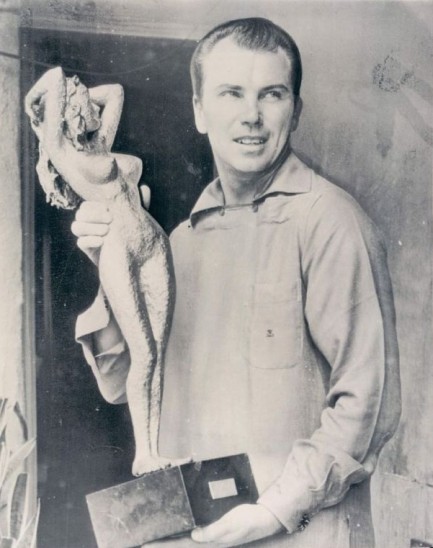
 A tale of albinos...and the witchdoctors who slice and dice them for cash. 
Tanzania has been recognized as one of Africa’s most politically stable and progressive nations since achieving independence in 1960. But this reputation has taken a hit since the killings of at least 30 albinos, perpetrated by men seeking body parts for witchcraft. Most of the killings have occurred in the past 10 months, including a grisly triple murder that took place hours after a large rally was staged in the capital city of Dar es Salaam to denounce the practice.
Among Tanzania’s population of 40 million are more than 200,000 albinos, whom superstition has surrounded since antiquity. But only recently have reports of killings begun to surface. The first confirmed albino killing for the purposes of witchcraft took place eight years ago, when half a dozen people were killed and skinned in Mbeya, in the southwest of the country.
Authorities say those involved in witchcraft—especially workers in the mining and fishing industries—believe albino body parts bring good luck. Demand is particularly high for albino skins, not just in Tanzania, but throughout a swath of Africa that includes Malawi, Zambia, Mozambique, South Africa, and the Democratic Republic of Congo. A single skin reportedly sells for anywhere between US $134 and $537. Killers also harvest victims’ arms, legs, hair, breasts and genitals, according to police. Local media have reported incidents of armless and legless victims who were left bleeding to death.
Zihada Msembo, who serves as secretary general of the Tanzania Albino Society and who is an albino herself, said, “When you sleep, you are unsure of waking up in one piece. They are cutting us up like chickens.” On her office wall hangs a photo of a limbless, partially skinned corpse, the result of a 2007 attack.
A Tanzanian woman named Susannah Rutahiro recently witnessed a killing, and gave a chilling first-person account that sounded like something out of a horror movie. She described eating dinner in an enclosed courtyard with her husband Nyerere when four men burst through the door and began to hack at him with machetes, screaming, “We want your legs! We want your legs!” What was left of her husband was laid to rest sealed in cement to prevent graverobbers from raiding his coffin.
|
 |

The headlines that mattered yesteryear.
2003—Hope Dies
Film legend Bob Hope dies of pneumonia two months after celebrating his 100th birthday. 1945—Churchill Given the Sack
In spite of admiring Winston Churchill as a great wartime leader, Britons elect
Clement Attlee the nation's new prime minister in a sweeping victory for the Labour Party over the Conservatives. 1952—Evita Peron Dies
Eva Duarte de Peron, aka Evita, wife of the president of the Argentine Republic, dies from cancer at age 33. Evita had brought the working classes into a position of political power never witnessed before, but was hated by the nation's powerful military class. She is lain to rest in Milan, Italy in a secret grave under a nun's name, but is eventually returned to Argentina for reburial beside her husband in 1974. 1943—Mussolini Calls It Quits
Italian dictator Benito Mussolini steps down as head of the armed forces and the government. It soon becomes clear that Il Duce did not relinquish power voluntarily, but was forced to resign after former Fascist colleagues turned against him. He is later installed by Germany as leader of the Italian Social Republic in the north of the country, but is killed by partisans in 1945.
|

|
|

It's easy. We have an uploader that makes it a snap. Use it to submit your art, text, header, and subhead. Your post can be funny, serious, or anything in between, as long as it's vintage pulp. You'll get a byline and experience the fleeting pride of free authorship. We'll edit your post for typos, but the rest is up to you. Click here to give us your best shot.

|
|


















 In 1971 Idi Amin overthrew Obote and installed himself as dictator. Taking notice of Bagaaya, who in addition to her legal background had been modeling for a few years, he appointed her Minister of Foreign Affairs. He had an ulterior motive. He wanted her to become one of his wives. Her answer—a hard no.
In 1971 Idi Amin overthrew Obote and installed himself as dictator. Taking notice of Bagaaya, who in addition to her legal background had been modeling for a few years, he appointed her Minister of Foreign Affairs. He had an ulterior motive. He wanted her to become one of his wives. Her answer—a hard no.












































































